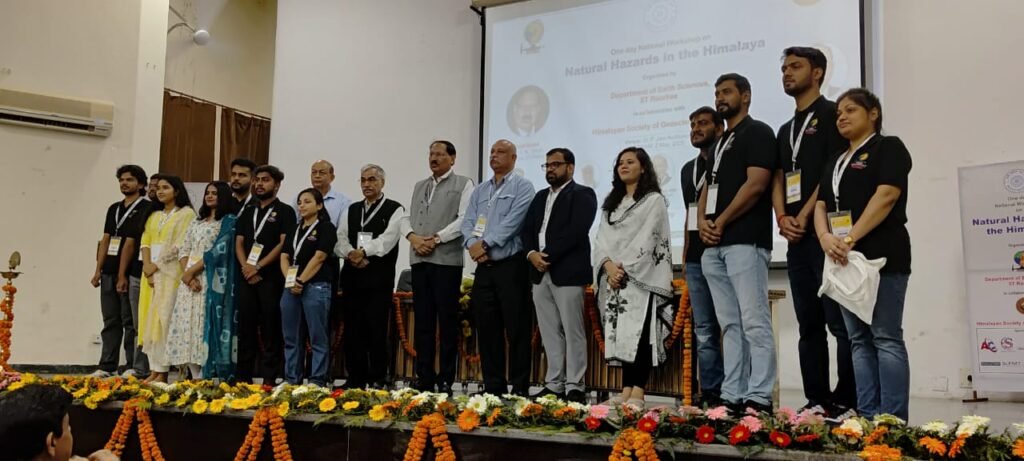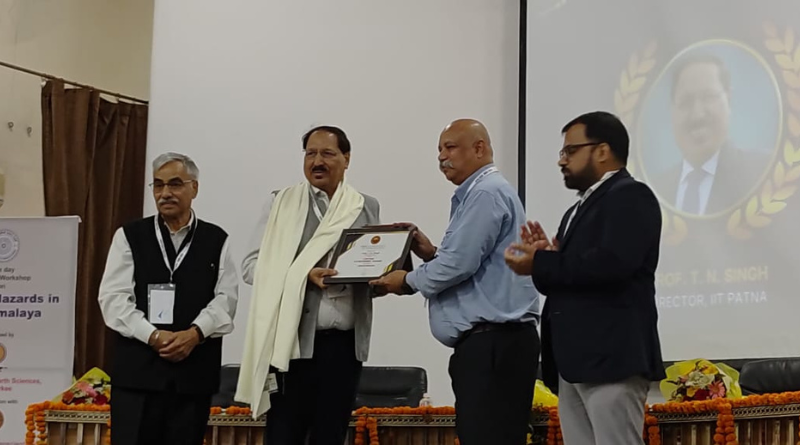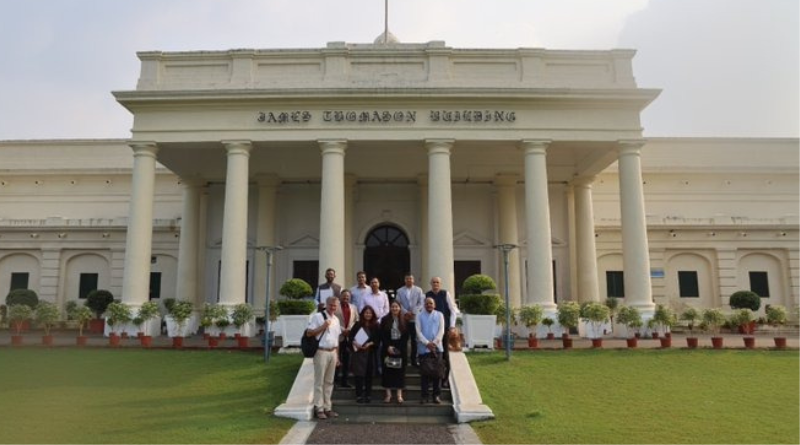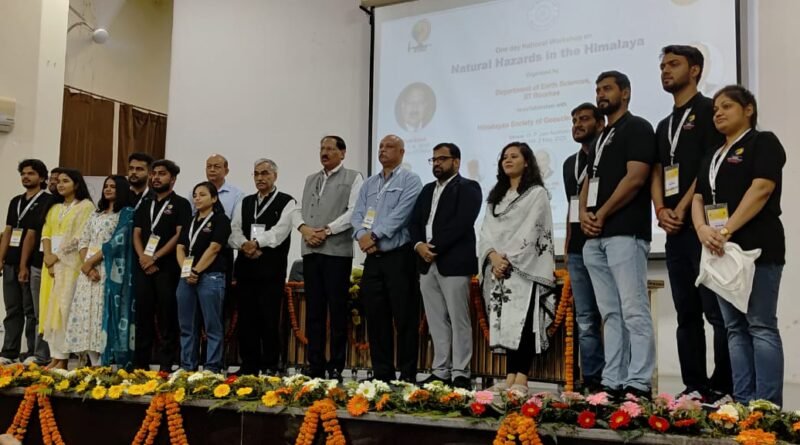IIT Roorkee hosts a National workshop on “Natural Hazards in the Himalayas” to advance risk mitigation and resilience research.

IIT Roorkee, May 7, 2025: The Indian Institute of Technology (IIT Roorkee), one of India’s
Premier technical institutions, organized a one-day national workshop on “Natural Hazards in the Himalayas” through its Department of Earth Sciences, in collaboration with the Himalayan Society of Geoscientists. The workshop brought together leading geoscientists, industry leaders, policymakers, and academicians to deliberate on the urgent need for integrated solutions to manage and mitigate the region’s growing geohazard threats.
The Department of Earth Sciences at IIT Roorkee has long been a center of excellence in research related to Earth systems and natural hazards. With its multidisciplinary approach, the department is dedicated to addressing the complex challenges posed by the geology and geomorphology of the Himalayan region. The Himalayan region. The department’s research spans various fields, including earthquake engineering, geohazards, climate change, environmental geology, and sustainable insfrastructure design. Through its world-class facilities and expertise, the Department of Earth Sciences plays a pivotal role in advancing both basic and applied research to inform disaster mitigation strategies in high-risk areas such as the Himalayas.
Stakeholders discuss Earthquake, Landslide, and Glacial flood Hazard at IIT Roorkee’s National workshop:
The Himalayan region, vulnerable to earthquakes, landslides, glacial lake outburst floods {GLOFs}, and extreme climatic events, demands immediate attention. The sessions on the development of early warning systems, and data-driven approaches for disaster resilience. With rapid infrastructure development, deforestation, and changing climatic conditions, the region faces severe risks that require a multi-disciplinary approach involving geologists, engineers, planners, and disaster management professionals.
The workshop was inaugurated by the chief guest, Prof. T.N. Singh, Director of IIT Patna, who emphasized the pivotal role of geosciences in national development and disaster resilience. He was joined by Prof. Sandeep Singh {Head Department of Earth Sciences, IIT Roorkee}, Shri B.D. Patni (Vice President, HSG}, Prof. K.K Pandey (Joint Secretary, HSG), and Prof. S. P. Pradhan (Organized Secretary). The speaker’s collectivity highlighted the importance of collaborative research, policy-level engagement, and technology integration in safeguarding the Himalayan region.
In his inaugural address, Prof. T. N. Singh emphasized the convergence of science and engineering in addressing Himalayan geohazards, stating, “We are now at a stage where isolated research is not enough What we need is a collaborative platform for knowledge sharing and rapid implementation.”
Prof. K.K. Pant, Director, of IIT Roorkee, in a message shared for the occasion, stated, “As a national leader in engineering research and education, IIT Roorkee is committed to applying scientific knowledge to societal challenges. This workshop reflects our continued efforts to build resilience in hazard-prone regions through advanced research, innovation, and stakeholder collaboration.’’

The workshop was inaugurated by the chief guest, Prof. T.N. Singh, Director of IIT Patna, who emphasized the pivotal role of geosciences in national development and disaster resilience. He was joined by Prof. Sandeep Singh {Head Department of Earth Sciences, IIT Roorkee}, Shri B.D. Patni (Vice President, HSG}, Prof. K.K Pandey (Joint Secretary, HSG), and Prof. S. P. Pradhan (Organized Secretary). The speaker’s collectivity highlighted the importance of collaborative research, policy-level engagement, and technology integration in safeguarding the Himalayan region.
In his inaugural address, Prof. T. N. Singh emphasized the convergence of science and engineering in addressing Himalayan geohazards, stating, “We are now at a stage where isolated research is not enough What we need is a collaborative platform for knowledge sharing and rapid implementation.”
Prof. K.K. Pant, Director, of IIT Roorkee, in a message shared for the occasion, stated, “As a national leader in engineering research and education, IIT Roorkee is committed to applying scientific knowledge to societal challenges. This workshop reflects our continued efforts to build resilience in hazard-prone regions through advanced research, innovation, and stakeholder collaboration.’’
National Experts Gather at IIT Roorkee to address mounting Geohazard risks in the Himalayan region:
The workshop featured a series of expert talks that provided comprehensive insights into critical geo-hazards affecting the Himalayan region, combining theoretical frameworks with practical field experience and cutting-edge technologies. Prof. T. N. Singh emphasized the growing threat of rockfall hazards and underscored the necessity of developing predictive models to safeguard lives and infrastructure. Shri B. D. Patni highlighted the complexities of Glacial Lake Outbrust Floods (GLOFs) and Landslide Lake Outbrust Floods (LLOFs), advocating for robust early detection systems and enhanced community preparedness. Prof Mahendra Singh delved into the mechanies of rock slopes, focusing on joint systems and failure criteria essential for slope stability assessment. Prof. Sandeep Singh provided a detailed geological perspective, illustrating how the intricate stratigraphy of the Himalayas contributes to localized hazards
Risks. Prof. N. K. Samdhiya stressed the importance of integrating geotechnical
And geospatial data to inform safer road construction and effective landslide mitigation

Strategies. Prof. Anand Joshi examined seismic risks in the region, noting the advancements in seismic investigation technologies, while Dr. Manoj Verman addressed the complexities of tunneling in fractured, high-relief Himalayan terrains. Collectivity, these expert sessions enriched the discourse on disaster resilience by presenting actionable insights grounded in scientific rigor and real-world relevance.
A panel discussion later in the day focused on fostering an interdisciplinary approach to disaster management in the Himalayas. Experts discuss the role of satellite monitoring,
Community preparedness and the integration of artificial intelligence in hazard prediction.
The panelist called for greater collaboration between academia, government bodies, and the private sector to enhance response capabilities and improve infrastructure resilience in the region.
The event concluded with industry presentations that underscored the real-world application of scientific research to infrastructure projects in high-risk zones. Topics include construction in fragile terrains and the role of data analytics in hazard zoning.
This workshop was a testament to IIT Roorkee’s role as a national leader in advancing disaster resilience strategies for the Himalayan region. It underscored the importance of cross-sector collaboration and the integration of scientific research into practical, sustainable solutions for disaster management.
The event concluded with a collective commitment to intensify research efforts,
Enhance early warning systems, and promote sustainable development that respects the ecological fragility of the Himalayas, ensuring long-term resilience for the region’s communities.
Also Read: COMET’25 at IIT Roorkee -A grand celebration of innovation, leadership, and excellence.
EOM.
